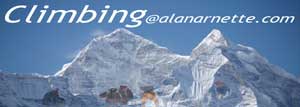 Q: Where is Mt. Rainier? Q: Where is Mt. Rainier?
A: It is in Rainier National Park in Washington
State in the US. It is a popular North American climb with
10,000 attempts each year. The nearest major city is Seattle
and major airport is Seattle-Tacoma International. The local
town is Ashford and the Park HQ is in Paradise, Washington.
Q: When is Rainier usually climbed?
A: The prime climbing time is from late May to mid September.
However some experts climb it year round but these climbers have tons of
experience. Weather can always be an issue, even in mid summer it can snow,
rain or hail at any time.
Q: How does Rainier compare with a Colorado/California 14er or
even Denali?
A: Snow! Rainier is snow covered on the upper part of all routes.
Also it is has significant and deadly glaciers. I have a good friend who
lost his climbing partner in one of these crevasse. Finally there is a real
threat of avalanches on all routes. While the altitude may be similar to
other 14ers, the weather and terrain put Rainier in a different class. Denali
is 6,000' higher and has even more brutal weather. But the long snow slopes
of the West Buttress route are similar so Rainier is a good training climb
for Denali.
Q: How hard is Rainier?
A: Depends on the route. There are over 60 named routes on
Mt. Rainier. The Disappointment Cleaver or Emmons Glacier routes are two
of the most popular by far and the most straight forward. Another standard
route is the Gibraltar Ledges. You gain almost 9,000' from trailhead at Paradise
inside the Park to the summit and cover 18 miles round-trip. Every route
to the summit requires helmet, crampons and an ice axe (the base definition
of "technical") plus traveling roped up due to crevasse danger.
A very few climb solo. You must be in top physical condition with an excellent
attitude to stand on the top. Also it is good to have some basic experience
under you belt with lower mountains and snow climbs to make your experience
more enjoyable.
Q: Is climbing Rainier dangerous?
A: Statistically it is not in the same league as Himalayan
mountains but that is little solace to the families of the 1 to 3 people
who die each year. Most deaths are attributed to weather and might have been
avoided by turning around earlier. There are hidden crevasses, falling rock,
steep slopes and extreme exposure on most routes. The Ingraham Glacier and
Liberty Ridge routes have seen the most deaths.
Q: How many people had summited and how many people had died trying?
A: My estimate is that over 185,000 people have summited Mt.
Rainier and around 90 have died since 1887, mostly from falls then avalanches.
The National Park Service states that about 10,000 attempt the summit summit
each year and 50% succeed. An ice avalanche on Ingraham Glacier killed 11
of a 29-member climbing party in 1981. This was deadliest U.S. climbing incident
ever. Several people die each year on the various routes. In June 2010, a
climber died in an avalanche on the Ingraham Glacier in spite of warnings from
Park Rangers of extreme avalanche danger. |
| Route
map |
| We took the Disappointment
Cleaver route on the right (West) side of the mountain in 2004 and
the Emmons-Winthrop Glacier route in 2012. I the
picture above above while flying into Seattle in 2004. It
is the Southeast side of Rainier which would be lower left
on this map. |
|

